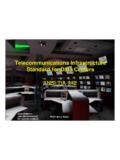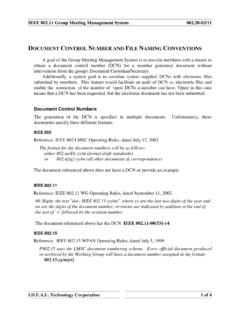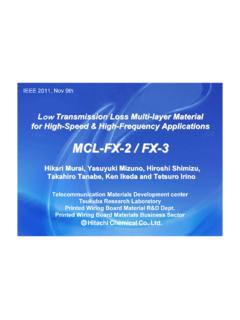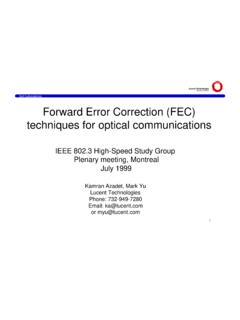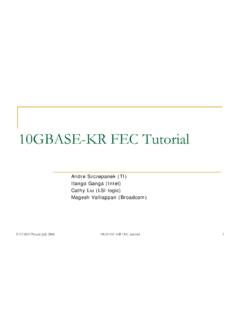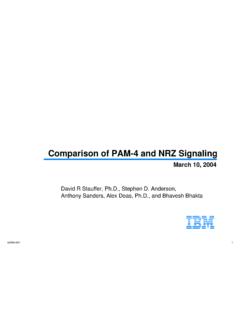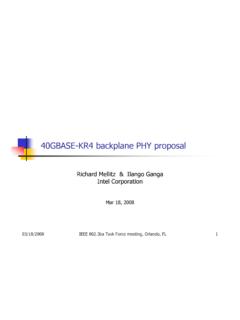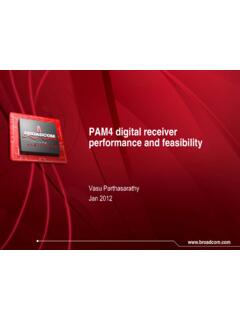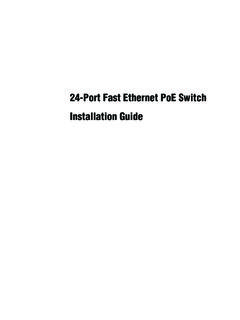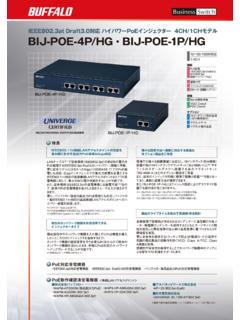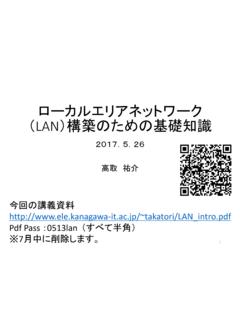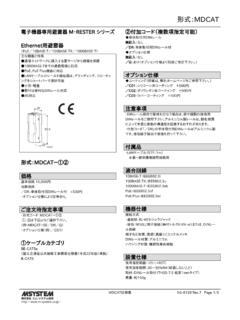Transcription of IEEE 802 10GBASE-T Tutorial
1 ieee 802 10 GBASEIEEE 802 10 GBASE--T TutorialT TutorialAlbuquerque, NMNovember 10, 2003 November 200310 GBASE-T Tutorial2 AgendaAgenda Overview Presenter: Brad Booth; Chair, 10 GBASE-T Study Group Cabling Presenter: Alan Flatman; Independent PHY Presenters: George Zimmerman; SolarFlareSailesh Rao; Intel Wrap-Up and Q&ANovember 200310 GBASE-T Tutorial3 ieee 802 10 GBASEIEEE 802 10 GBASE--T TutorialT TutorialOverviewOverviewContributors: Shimon Muller, Sun MicrosystemsJeff Warren, Independent ConsultantGeoff Thompson, Nortel NetworksBruce Tolley, Cisco SystemsBrad Booth, Intel CorporationNovember 200310 GBASE-T Tutorial4 What What Where Where Who Who Why Why --WhenWhen What is 10 GBASE-T? It s a New 10GE PHY using the existing MAC Whereare the 10 GBASE-T applications? Initially in the Data Center, but also the Horizontal Whowill implement 10 GBASE-T products? Both Server and System Vendors (for data & storage) Why is 10GE over copper important?
2 Cost $$$ It s cheap relative to 10GE Optical When will it be available? Typical standards timeline: 1sthalf of 2006 November 200310 GBASE-T Tutorial5 WhatWhat: 10 GBASE: 10 GBASE--T Initial GoalT Initial Goal Initial Goal from Call-for-Interest 10 Gigabit Ethernet over horizontal structured, twisted-pair copper cabling 10 Gigabit Ethernet MAC and media independent interface as specified in ieee , 2002 Copper cabling is assumed to be ISO/IEC-11801:2002 Class D or better copper cableNovember 200310 GBASE-T Tutorial6 WhatWhat: 10 GBASE: 10 GBASE--T ObjectivesT Objectives Keeping it Ethernet Preserve the frame formatat the MAC Client service interface Preserve min. and max. frame sizeof current Std. Support star-wired local area networks using point-to-point linksand structured cabling topologies Keeping it 10 Gigabit Ethernet Support full duplexoperation only Support a speed of Gb/sat the MAC/PLS service interface Compatibility with Support Clause 28 auto-negotiation To notsupport (EFM) OAM unidirectionaloperation Support coexistence with (DTE Power via Ethernet)November 200310 GBASE-T Tutorial7 WhatWhat: 10 GBASE: 10 GBASE--T Objectives (T Objectives (con tcon t.))
3 Speed, Media & Reach Select copper media from ISO/IEC 11801:2002, with any appropriate augmentation to be developed through work of in conjunction with SC25/WG3 Support operation over 4-connectorstructured 4-pair, twisted-pair copper cablingfor all supported distances and Classes Define a single 10 Gb/s PHYthat would support links of: At least 100 mon four-pair Class F (Cat 7)balanced copper cabling At least 55 m to 100 mon four-pair Class E (Cat 6)balanced copper cabling Environmental Meet CISPR/FCC Class A Support a BER of 10-12on all supported distances and ClassesNovember 200310 GBASE-T Tutorial8 WhereWhere: 10 GBASE: 10 GBASE--T ApplicationsT ApplicationsYes(< 15m)YesYesData CenterServer ClusteringNoNoYesCampus & MetroNoNoYesVertical (Risers BB Links) Within Building NoYesNoHorizontalIn Building (inc. wiring closet)10 GBASE-CX4( )10 GBASE-T10 GBASE Fiber( )ApplicationNovember 200310 GBASE-T Tutorial9 WhereWhere: 10 GBASE: 10 GBASE--T MarketsT Markets 1st The Data Center Density of compute devices (modular platforms) Need more bandwidth per link than 1000 BASE-T or link aggregation can provide Less constrained by installed base or structured cabling standards If there is no way to verify the circuit, I will install new cabling.
4 M. Bennett, Lawrence Berkeley Lab 2nd Horizontal Enterprise Networks Higher speed aggregation points in the wiring closets Needs to conform to structured cabling standards Future build outs will utilize enhance cabling specifications Today s server is tomorrow s desktop .. S. Muller Not by 2006, but eventually it will happen as costs drop and bandwidth intensive applications increaseNovember 200310 GBASE-T Tutorial10 WhoWho: 10 GBASE: 10 GBASE--T Usage/DevelopmentT Usage/Development Manufacturers of 10 GBASE-T Products Data center & wiring closet LAN switching vendors Data and storage server vendors Module vendors End-User Profile: Lawrence Berkeley Lab 14,000 network attached devices 2003 year end 1,000 devices attached via 1000 BASE-T by 2006 Horizontal limited to 100m follow TIA/EIA-568-B If necessary, willing to pull new cabling for 100m of 10 GBASE-T ieee 10 GBASE-T Standards Participation Nov 2002: CFI Attendance included 69+ vendors and users July 2003: Technical development of Std.
5 Inc. 34+ companies Sept. 2003; Portonovo, Italy: Attendance of 40 people Almost as many as EFMN ovember 200310 GBASE-T Tutorial11 10 GBASE-T vs. 1000 BASE-T Absolute cost will be 8-9x and trend toward 2-3x Cost per gigabit will start at 10 GBASE-T vs. 10GE Fiber E-only vs. EOE Absolute cost will target fiber (short reach - SR) and trend to s Law in Action!1G vs. 10G Relative Cost Target024681020042005200620072008 TimeRelative Cost (1G 04=1)1G10G10G Fiber vs. 10 GBASE-T Relative Cost (Fiber 04=1)Fiber10 GBTS ource: Cahners In-stat, CFI GroupWhyWhy: 10 GBASE: 10 GBASE--T Relative CostsT Relative CostsNovember 200310 GBASE-T Tutorial12 WhyWhy: 10 GBASE: 10 GBASE--T ImportanceT Importance Faster network link speeds provide new generation of systems Modular switches and servers Backplanes and switch fabrics aggregate to support multiple 10 GBASE-T ports Servers with faster I/O subsystems ( PCI Express ) Low cost solutions are market stimulus 10 GBASE-CX4 is a step in the right direction, but limited reach 10 GBASE-T: Addresses PHY costs concerns in Enterprise market Enhances reach and conforms to structured cabling environments Lower cabling costs Installation practices are well-known Ease of installation Cost of terminationNovember 200310 GBASE-T Tutorial13 When:When.
6 10 GBASE10 GBASE--T TimelineT TimelineJULJULNOVNOVMARMAR20042004 JULJULNOVNOVMARMAR20052005 JULJULNOVNOVMARMAR20062006 JULJULT utorialTutorial& CFI& CFI802 SEC 802 SEC !Std! Are HereNovember 200310 GBASE-T Tutorial14 ieee 802 10 GBASEIEEE 802 10 GBASE--T TutorialT TutorialCablingCablingContributors: Shadi AbuGhazeleh, Hubbell Premise WiringRandy Below, The Siemon CompanyChris DiMinico, MC CommunicationsAlan Flatman, Independent ConsultantValerie Rybinski, Hitachi Cable ManchesterBruce Tolley, Cisco SystemsSterling Vaden, Superior Modular ProductsNovember 200310 GBASE-T Tutorial1510 GBASE10 GBASE--T Cabling ObjectivesT Cabling Objectives Support operation over 4-connector structured 4-pair, twisted-pair copper cabling for all supported distances and classes Define a single 10 Gbit/s PHY that would supports links of: at least 100m on four-pair Class F balanced copper cabling at least 55m to 100m on four-pair Class E balanced copper cabling Support star-wired local area networks using point-to-point links and structured cabling topologies Select copper media from ISO/IEC 11801:2002, with any appropriate augmentation to be developed through work of in conjunction with ISO/IEC SC25 WG3 Meet CISPR/FCC Class A EMC limits Support a BER of 10-12 on all supported distances and classesNovember 200310 GBASE-T Tutorial16 Class E Channel PerformanceClass E Channel Performance01020304050607015010015020025 0 Frequency (MHz)dBSource: ISO/IEC 11801:2002 Insertion LossReturn LossPS NEXTPS ELFEXTN ovember 200310 GBASE-T Tutorial17 Class F Channel PerformanceClass F Channel Performance010203040506070dB110020030040 0500600 Frequency (MHz)Source: ISO/IEC 11801.
7 2002 Insertion LossReturn LossPS NEXTPS ELFEXTN ovember 200310 GBASE-T Tutorial18 Worldwide Structured Cabling Deployment:Worldwide Structured Cabling Deployment:Installed Base Forecast for Dec 2005 Installed Base Forecast for Dec 2005 Cat 7/Class 5/old Class D15% 6/Class E34%Cat 5e/new Class D50%Source: LAN Technologies (Jan 2003)Source: LAN Technologies (Jan 2003)total outlets925 millionNovember 200310 GBASE-T Tutorial190%5%10%15%20%25%10203040506070 8090100110 Commercial Office Structured Cabling:Commercial Office Structured Cabling:Channel Length vs % DistributionChannel Length vs % DistributionSource: Flatman, Fluke, Hubbell, Nordx/CDT, Siemon (total sample >108,000 cabling links)accumulated figures(70% lengths <55m) Length (metres) 200310 GBASE-T Tutorial20 Installing New Cabling for 10 GBASEI nstalling New Cabling for 10 GBASE--TTIEEE 10 GBASE-Tminimum cablingchannel requirements100% coverage of channels up to 100mAugmentedClass E/Class Fcabling+specified by cabling group(s)specified by ieee 200310 GBASE-T Tutorial21 Using Installed Class E Cabling for Using Installed Class E Cabling for 10 GBASE10 GBASE--TTIEEE 10 GBASE-Tminimum cablingchannel requirements100% coverage of channels up to 55m*Re-characterisedlegacy cabling- extended frequency- alien crosstalk- field testing+specified by cabling group(s)
8 Specified by ieee * 70% of all Class E/Cat 6 channels are less than or equal to 200310 GBASE-T Tutorial2210 GBASE10 GBASE--T Cabling CharacterisationT Cabling Characterisation Performance models established by 10 GBASE-T Study Group Measurement data for Class D - F cabling to 625 MHz Data includes screened & unscreened cabling systems Measured data has been scaled to established limits Data captured for Cat 5e/Class D, Cat 6/Class E, Cat 7/Class F: Insertion Loss Return Loss Pair-to-Pair NEXT Power Sum NEXT Pair-to-Pair FEXT Pair-to-Pair ELFEXT Power Sum ELFEXT Alien Crosstalk also investigated by 10 GBASE-T Study Group Valuable measurement data establishedNovember 200310 GBASE-T Tutorial2310 GBASE10 GBASE--T Cabling T Cabling --Key TasksKey Tasks Define worst case cabling channel requirements for 10 GBASE-T Request cabling standards group(s) to verify channel requirements This may be an iterative process Request cabling standards group(s) to develop industry specs augmented Class E & Class F re-characterised legacy cabling alien crosstalk mitigation methods alien crosstalk test methodWorth noting:Worth noting: ISO/IEC & TIA cabling groups proactively engaged in SG ISO/IEC SC25 WG3 working on alien crosstalk management & offer to assist ieee in augmentation work necessary for Class E & Class F cabling.
9 TIA TR-42 has outlined projects to assist ieee in augmentation and extended frequency characterisation. This work will also establish the relationship of transmission parameters and alien crosstalk plus their field testing and 200310 GBASE-T Tutorial24 ieee 802 10 GBASEIEEE 802 10 GBASE--T TutorialT TutorialPHYPHYC ontributors: Joseph Babanezhad, Plato LabsSanjay Kasturia, TeraneticsGeorge Zimmerman, SolarFlare CommunicationsSailesh Rao, Intel CorporationNovember 200310 GBASE-T Tutorial25 Comparison with 1000 BASEC omparison with 1000 BASE--TT Full duplex operation only Half duplex operation is not supported in MAC 1000 BASE-T supported carrier extension for 1G repeaters The Tutorial assumes signaling methodology which was the basis for most study group discussion Throughput is 4 (lanes) x 833 Mbaud x 3 bits/baud = 10Gb/sFEXT Cancellation requiredNo FEXT Cancellation833 Mbaud, ~450 MHz used bandwidth125 Mbaud, ~80 MHz used bandwidthFull duplex echo-cancelled transmissionFull duplex echo-cancelled transmission8-state 4D Trellis code across pairs8-state 4D Trellis code across pairs10-level coded PAM signaling (3 information bits/symbol)
10 5-level coded PAM signaling (2 information bits/symbol)10 GBASE10 GBASE--TT1000 BASE1000 BASE--TTNovember 200310 GBASE-T Tutorial2610 GBASE10 GBASE--T Block DiagramT Block DiagramRJ45RJ45 LineDriverLineDriverClockRecoveryClockRe coveryAnalogFilteringAnalogFilteringADCA DCC lockGeneratorClockGeneratorDSPDSPDACDACS cramblerScramblerMACI nterfaceMACI nterfaceRx 200310 GBASE-T Tutorial27 Key issuesKey issues Higher symbol rate requires higher signal bandwidth Class D (Cat 5e), if used, will be utilized beyond its specifiedfrequency range Class E (Cat 6) will have to have it s performance characterized beyond 250 MHz and up to 625 MHz TSB being prepared by TIA Class F (Cat 7) is adequately specified TIA and ISO are engaged in extended frequency and alien crosstalk augmentation and characterization of Class E & F Higher symbol rate and higher level modulation imply Higher performance requirements on the Analog Front End More complex signal processing Cancellation of FEXT Aggressive timing requirements Alien Crosstalk is a significant factor in capacity on UTPN ovember 200310 GBASE-T Tutorial28 Achievable PerformanceAchievable Performance With the 4 connector model and proposed signaling.
